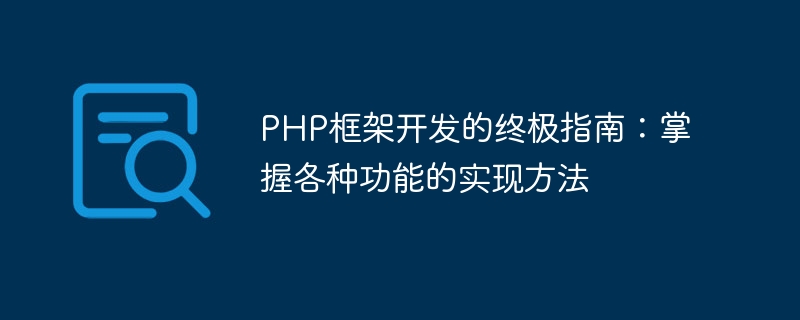
The Ultimate Guide to PHP Framework Development: Master the Implementation Methods of Various Functions
As a powerful and widely used programming language, PHP has greatly promoted Web applications and website development. In order to improve development efficiency and code quality, many developers choose to use the PHP framework to build projects. However, how to develop an efficient, stable, and scalable PHP framework is a topic that requires in-depth research and exploration. This article will provide you with an ultimate guide to PHP framework development to help you master how to implement various functions.
1. Design framework architecture
Before developing a PHP framework, you first need to consider the overall architecture of the framework. A good framework should have a clear directory structure, modular organization, and scalable architecture. When designing the framework architecture, you can consider the following factors:
- Directory structure: Store the core code of the framework separately from the application code to facilitate maintenance and upgrades. At the same time, reasonable division of directories can improve the readability and maintainability of the code.
- Routing system: Design a flexible and efficient routing system to map URLs to corresponding controllers and methods. Consider using regular expressions to implement dynamic routing.
- Controller and model: Design a concise and clear controller and model system for processing requests and data display. Reasonably divide the responsibilities of the controller and the model to improve the reusability and testability of the code.
- Database access: Design a convenient, safe and efficient database access layer for operating the database. This can be achieved using PDO or ORM libraries.
- Cache and log: Design a reliable cache system and log system to improve performance and facilitate troubleshooting.
2. Implement core functions
After designing the framework architecture, you need to start implementing the core functions of the framework. Specifically, the following aspects can be considered:
- Automatic loading: Implement an automatic loader to automatically load framework core classes and application classes. This avoids the hassle of manually importing each class file.
- Error handling: Implement an error handler to capture and handle errors and exceptions during PHP running. Error information can be recorded in the log to facilitate troubleshooting.
- Session management: Implement a session manager to process user session information. You can use the native PHP session management mechanism, or you can use third-party libraries to simplify operations.
- Route parsing: Implement a route parser to parse URLs into corresponding controllers and methods. Dynamic routes can be parsed using regular expressions.
- Controller and model: Implement the controller and model system to process requests and obtain data. Some commonly used methods can be encapsulated and provided to application developers.
3. Expand the framework functions
Once the core functions of the framework are implemented, you can consider how to extend the functions of the framework and provide them to application developers. The following are some common extension functions:
- Form validation: Implement a form validator to validate form data submitted by users. Various validation rules can be defined, such as required fields, length limits, regular matching, etc.
- File upload: Implement a file upload class to process files uploaded by users. File size and type can be limited and saved to a specified directory.
- Cache system: Implement an efficient and reliable cache system to improve the performance of data access. Can support multiple cache backends, such as files, databases, memory, etc.
- Log system: Implement a flexible and configurable log system to record log information during application operation. Can support multiple log levels and log output methods.
- Authentication and authorization: Implement user authentication and authorization functions to protect application security. You can use Session, Token, OAuth and other methods to implement user login and permission control.
Finally, a good PHP framework is not just a pile of code, it also needs good documentation and community support. In order to help users better use the framework, detailed documentation and sample code can be written, and an active community can also be established to provide technical support and communication platforms.
To sum up, developing an efficient, stable, and scalable PHP framework is a complex and challenging task. Through reasonable architectural design and implementation of core functions, coupled with support for extended functions, an excellent PHP framework can be developed to improve development efficiency and code quality. I hope the guidelines in this article can be helpful to PHP framework developers and create more innovative and exciting frameworks.
The above is the detailed content of The ultimate guide to PHP framework development: Master how to implement various functions. For more information, please follow other related articles on the PHP Chinese website!

